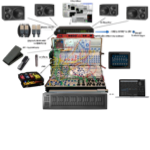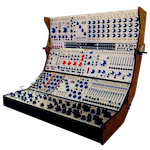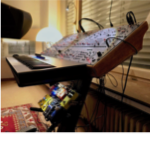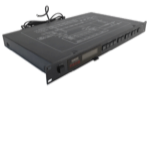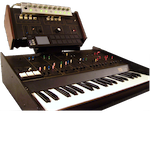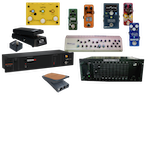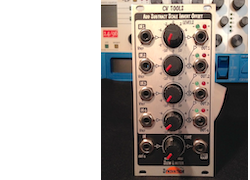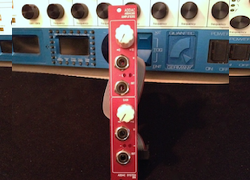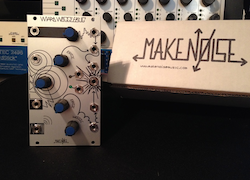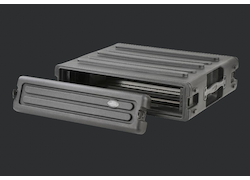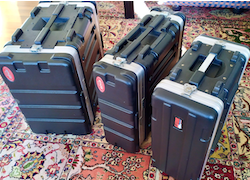Stage-Synthesizers
The following is a short list of synthesizers
a): that have a): have been with me for a while (2003 to 2015), but didn't make it to the main stage; or
b): digital synthesizers I was quite happy working with for a while, but they were essentially more of a substitute for something I wasn't yet able to realize (1986 to 1993). However, they were MIDI (and SysEx) controllable and perfect for me to combine with the computer.
Moog
MiniMoog Model D
It was (in particular sonically) not mini. It was larger and significantly in weight than the ARP Odyssey and, compared to ARP, it could do almost nothing. But it was really something special and, despite all the shortcomings, absolutely impressive. From the sound perhaps, the most recognizable Synthesizer of the 70s - and that may also be a problem.
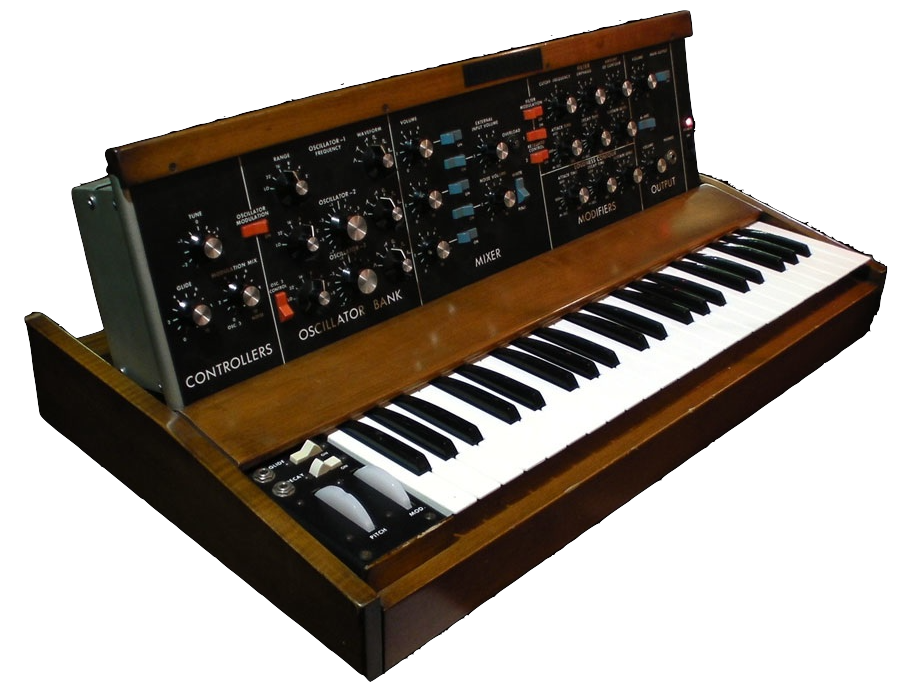
The combination of the very rich sounding VCOs with the (rightly) renowned filter is an extremely musical one. Due to its warmth (adding even harmonics) the Mini is also quite "dirty", which can lead to wonderful sounds. Its orientation is more in the interaction of the three VCO's - tunings - and Filter progressions. Wonderful sounds are to be produced by using Frequency Modulation (FM), if Osc3 is used as the modulation frequency for Osc1 and the Mod-Wheel is opened.
Sounds reminiscent of screaming electric guitars are stimulated by the "Amount Of Contour" parameter - due to the filter's behavior, Amount behaves like a kind of drive control to some extent. By feeding the signal back into the synth's audio input, even more extreme, distorted sounds can be created. Downright dirty!
This Synthesizer exerts an austere magic and it is difficult to escape from it. A haunting synth for any kind of melodies, but equally for more abstract sounds. Abstraction is achieved mainly by detuning the 3 VCO's, by using filter progressions and the use of the Mod wheel (especially with FM). Filter Emphasis (resonance) and Contour Amount are crucial parameters that ideally complement the sound of these VCO's.
The MiniMoog Model D, especially when equipped with the "old" oscillator (like my model), is the only Synthesizer I know that sounds like a big - very big - Synthesizer. It's not quite "mini" either. And it has a considerable weight. It is, without question, one of the most beautiful synths ever built, and the flip-up control panel is unmatched to this day.
The Minimoog Model D is a "conglomerate", including in terms of its construction: Everything has something to do with everything! Just the tuning of the oscillators (6 trimmers tuned to each other) is a nightmare and emblematic of this instrument in terms of technology. The interior is both daunting (stuffed) and beautiful at the same time. Many missing modulation possibilities (e.g. RM) it counterbalances with its "richness" in sound.
It has a very clear character and thus also an extremely high recognition value! For some people this was a problem. However, I succeeded in making the Mini not sound like Moog: using the EMS Filterbank B1-II behind the Mini, a whole range of other worlds opened up!
Although I really was fond of the instrument, I have never used it in musical projects. It's geared too much towards "pop music" and modifications were just out of question to me. Together with Eric van Baaren, however, I had assisted (under his guidance, of course) in restoring the instrument to such beautiful condition. When I obtained the instrument in Chicago, it was in a really poor state and one thing I discovered was a mouse's nest! The entrance was under the top three keys, which stood up, and the actual nest was on the other side, underneath the pitchbend wheel. The black strip (at the top of the refurbished Mini) was a Velcro strip to which I could attach two joysticks (with a MIDI circuit board).
In order to finance the Buchla, I finally parted with the Mini in 2015.
Moog Prodigy
The Moog Prodigy was the Moog that had not been designed by Robert Moog himself, yet sounded distinctly like a Moog. Originally a "low-cost" synth that appeared as a gateway drug to many people - I believe that it cost $400 new and was (initially?) offered exclusively at RadioShack. It was the first Moog I had encountered (in the 80s) - long before I had purchased my Prodigy pictured here. I had chosen this synth as an expanding "solo voice" for my Fender Rhodes electric piano.
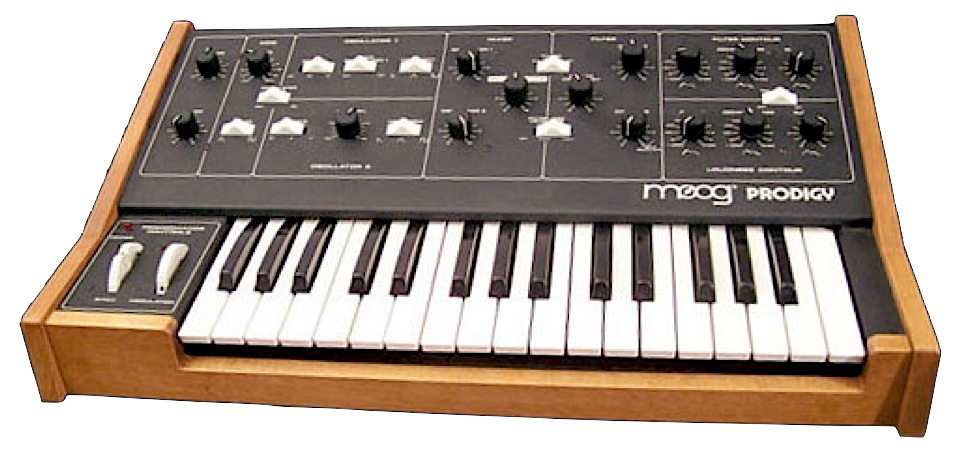
Particularly with the Fender Rhodes E-Piano, this synth was straightforward to use on melodies that offered more sustain than a piano is capable of - and that was a musical game-changer (for pianists). Besides, it was small and easily transportable - the perfect match for any jam session. Also, the Prodigy's sonic spectrum was just about sufficient for it to be played as a solo instrument over the length of a concert while still being tonally variable enough not to seem monotonous. However, it was not suitable at all for electronic experiments.
EDP (Electronic Dream Plant)
WASP Deluxe
With this, extremely rare, EDP WASP Deluxe (serial number 003) my second Synthe-Odyssey had started again. In 2003 it came along and I was thrilled to hear/play an analog synth again. The enthusiasm remained, even after I learned that the WASP is completely digital - it was one of the first digital synths. But it doesn't sound digital at all. It is a very unique and great synth. I liked it better than the little Wasp. just because of the keyboard.
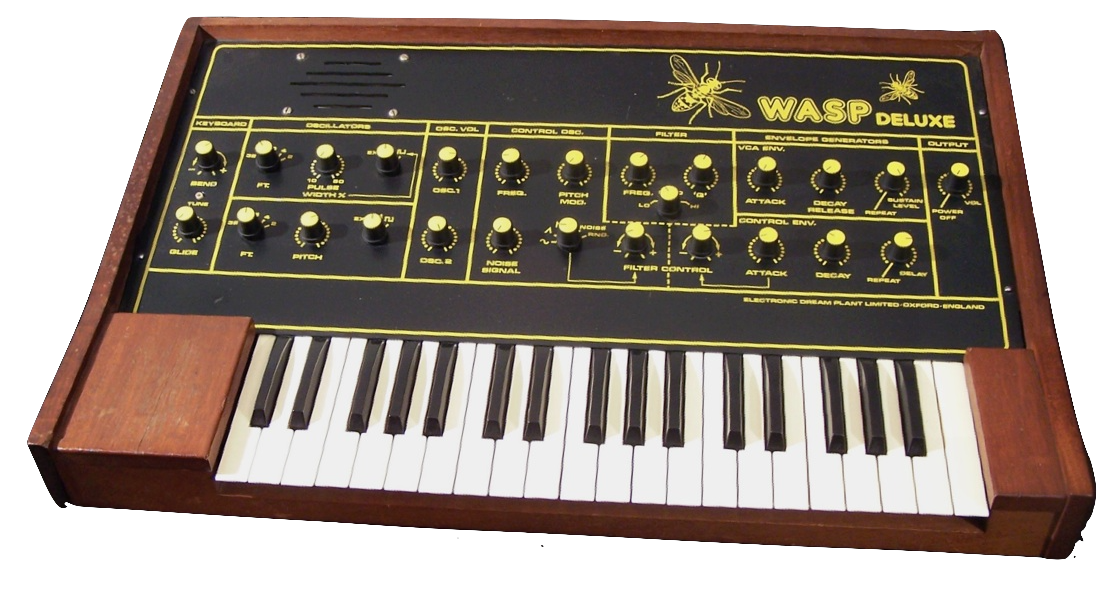
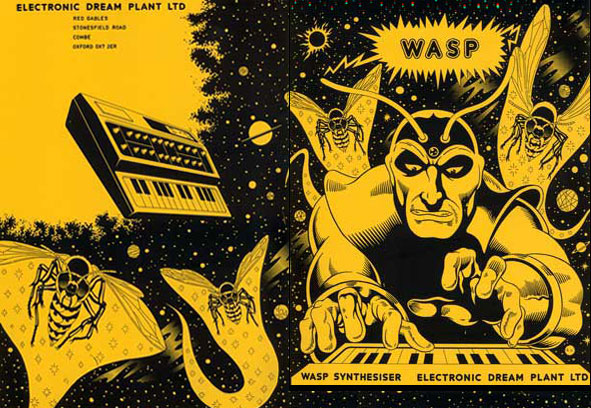 The Wasp may be somewhat one-sided, but everything that can be done with it sounds good. It's famous for the filter design. Everything has character and its own charm. The direction is rather psychedelic, spacey, but it's also great for melodies. It was nothing to travel - it is astonishingly large (but lightweight), and, with under 80 instruments ever built, far too rare to expose it to such strains.
The Wasp may be somewhat one-sided, but everything that can be done with it sounds good. It's famous for the filter design. Everything has character and its own charm. The direction is rather psychedelic, spacey, but it's also great for melodies. It was nothing to travel - it is astonishingly large (but lightweight), and, with under 80 instruments ever built, far too rare to expose it to such strains.
Because it didn't meet my requirements, I sold it for funding my upcoming ARP Odyssey odyssey.
My Digital Sound Generators 1986-93
By the end of the 80s I had switched to 19 inches - I didn't feel like carrying the 50kg Rhodes Chroma anymore, the ARP 2600 couldn't do on its own what I wanted to achieve, and I was just making my first computer experiences (I also had MIDI-fied the Rhodes Chroma). The Yamaha synths could do FM and were completely remote controlled via SysEx data.
Since 1986 I had a mobile computer setup, first with a "Commodore 64" and Dr. T's "Algorithmic Composer" software (with Rhodes Chroma and Casio CZ101), followed by Atari St1040 with "M" software (with Yamaha synths and AKAI S1000). In 1989 Max was released and my first Apple was a SE30. Max allowed to write programs with such SysEx addressings and that was like a revolution! The equipment didn't really get smaller or lighter: I had a 12U and a 10U case, both hardly moveable by one person. However, I suddenly could do with the synths what previously was done only with priceless and stationary machines! The Max software and the computer had turned these instruments into powerful creatures.
Noticeable is the big change of the instrument "synthesizer" during the 80s: Now mostly made of plastic or in 19' rack version, polyphonic instead of mono- or duophonic, but suddenly no more knobs, but instead push buttons, step menus, one (1) encoder knob (or up/down buttons), monitor info display (or LCD). The playfulness was gone. Intuitive access to the parameters: impossible. For the years to come, the main focus for me was on controlling the parameters via MIDI or MIDI Controller. With the appearance of motor faders, I spent most of my time "listening" to their ( unreleased) control commands and writing my own software and customizations. This was the final step into electronics for me, as there was simply not enough time to play piano and electronics at the same time.
Casio CZ-101
This toyish thing was my entry into the world of digital sounds. It was an ideal counterpart to the Rhodes Chroma (ARP) and I got the craziest sounds out of it - cartoon-style.

The CZ101 was downright cheap (I think I paid DM 300.-), but in a certain way it managed to keep up with the big guys - for my intents and purposes it was just perfect. The synthesis was called "Phase Distortion Synthesis" and sonically it was close to FM - but a lot easier in its programming.
Yamaha TX-816
I was never into the Yamaha DX7 - most of the music I had located the DX7 in, I found to be awful. All these plastic synths that were suddenly entering the market did not leave me with a good feeling - not when listening to them, neither while playing them. The transformation of the synths into preset slingshots was suspicious to me, the elimination of the controllers (pots and sliders) being a reason for exclusion.
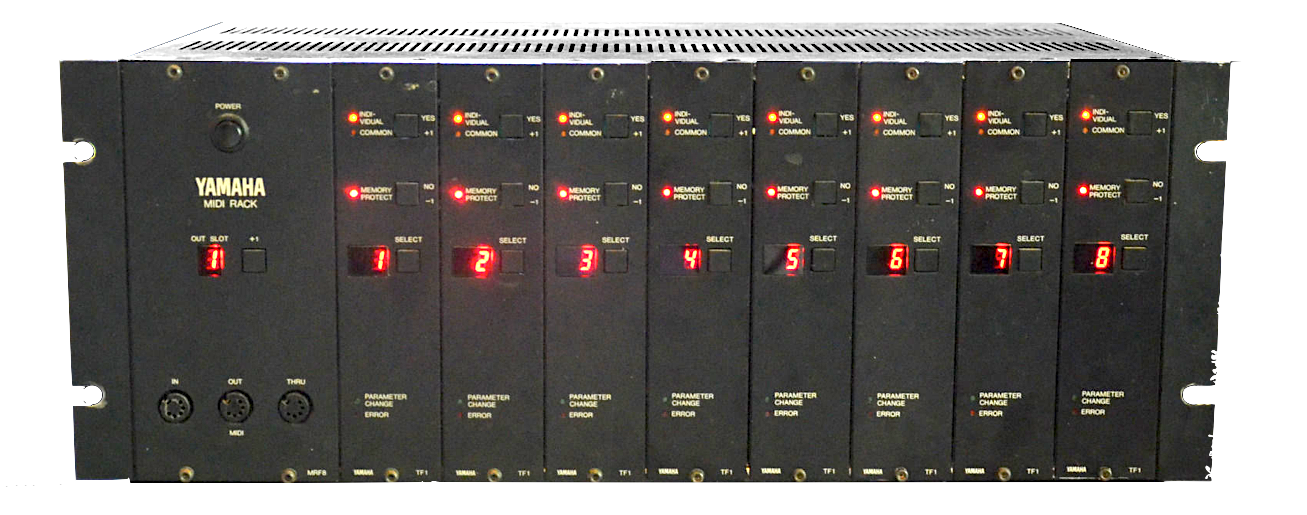
Then I came across a Yamaha TX816: 8x DX7 in a 19' 4U cabinet. A 12kg beast. The TX816 featured 128 voices - real-time editable via SysEx - and the computer allowed multiple assignments. The "knobs" were back and controlled even more complex than by hand due to the computer. The TX816 appeared to be virtually inexhaustible!
It was particularly exciting when loading identical presets in all modules and detuning them very slightly against each other. When the processing - also 8-fold parallel - was applied, incredible binaural beats could be created by volume changes. The TX816 finally became an obsolete device for me when I got the M.A.R.S. that had to be paid for somehow. My TX816 probably still lives in the "Experimental Studio of the SWF" in Freiburg.
Yamaha TG-77
The Yamaha TG77 was my favourite Synthesizer in the beginning of the 90s. I have hardly used the Multimode - as the "hybrid" part (Waves). So I did not use most of it.

The TG77 was controllable via SysEx as well and could do some fantastic FM sounds. I found it so good that I later also purchased a SY99, the large keyboard version. It was the first synthesizer I fully "decoded". It probably wouldn't have been of interest to me without the "Max" software package, though with Max it became one of the most accessible synths you could get at the time.
Below is a live recording (1991) of a piece (in the rarely used Multi-Mode of the TG77) which I had performed with this synth, an Akai S1000 and MAX. Frank Gratkowski is playing alto saxophone (partly played as an indistinguishable sample). Lars Lindvall performs trumpet (and whistles) and Norbert Pfammatter playing the drums. The Electric Bass, Marimba, Vibraphone, etc. - it's all the TG77. And of course it is all "live" - without any sequences. At that time I was interested in "intelligent" extensions of the performers' manual technique, i.e. harmonization, sound control - or interval series of e.g. saxophone or trumpet, which were recorded by a MIDI mic and sent to the computer and were recognized which triggered or switched some thing.
Yamaha DMP-11
All the synth outputs required being organized and I just had discovered the world of 4-channels. Therefore I used a Mackie Mixer with OTTO (MIDI automation). The Yamaha DMP11 mixer served for the 8 outputs of the TX816 - It was MIDI controllable and made it possible to do things that were impossible before, respectively too big and too expensive to even be considered.
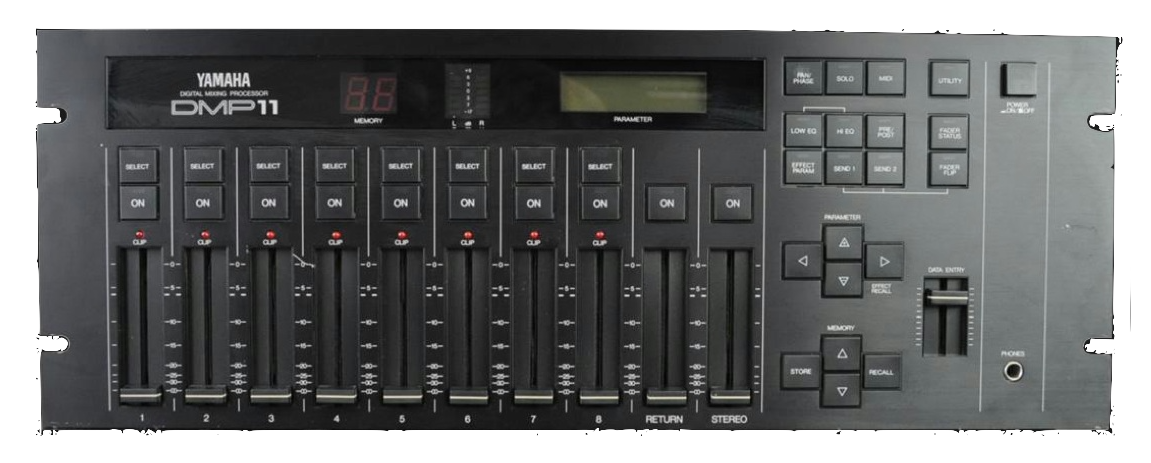
I have forgotten how, but it was quite some trickery. Both Mixers did not fully understand all the MIDI commands, or did not allow everything, however, in the addition of both, the bounds where to be overcome.
AKAI S-1000
The AKAI S1000 belongs to a place of honor in my synth pages - after all, it's a Sampler, not a Synthesizer. It was the instrument that made all the difference in my last synth setup before the M.A.R.S.. I was lucky enough to know the " General Importer" at the time, who told me that the AKAI 1000 had been introduced, but would be delayed in delivery due to a revised front panel. So I became one of the first owners of an S1000. Actually, this sampler was a true milestone: the first time 16bit, 44.1kHz and Stereo. A digital tape recorder! During the first years, Samplers were really expensive and sounded more like "synth sound" or, worse, like toys. The S-1000, however, had a sound quality that reminded of top studios - plus it was affordable.
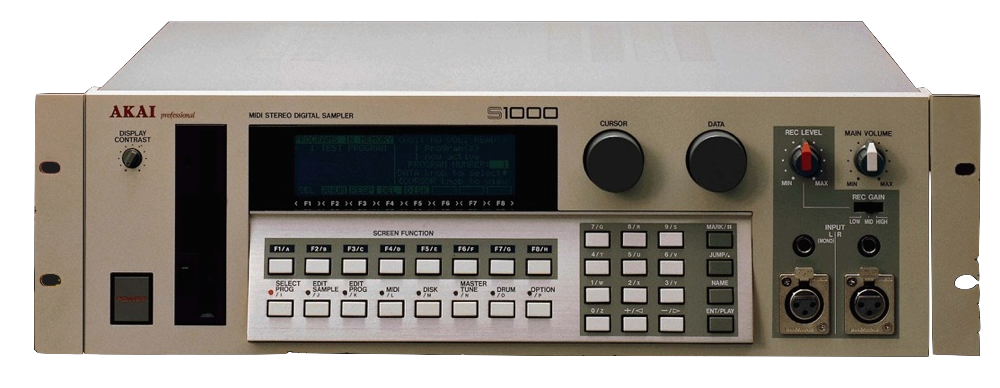
Right from the start, I had clear ideas about what I wanted to do with the S1000: Live sampling, controlled via a MAX interface! - and with this ambition I was pretty well on my own in the "sample scene". Maintaining sample banks on floppy disks, instrumental surrogates or fun and effect samples ("playing Beethoven's 5th with your own farts") was definitely none of my business. I intended to use the sampler as a "real-time tape recorder", in the sense of the classical tape processing of concrete sounds in early electronic music. Actually, this generation's devices were pretty much all built in a similar way, and you could get into them pretty fast. They consisted mainly of a step menu. Having two large wheels (Cursor and Data) made the S1000 faster compared to other devices, but it wasn't anywhere near fast enough for live sampling. That's why I also wrote a SysEx MAX patch for the S1000 at the very beginning.
While the S1000 featured MIDI, the individual parameters did not have any addresses (as is the case with Yamaha, for example). Instead, just the buttons and knobs had been addressed. On the S1000 it was necessary to tap and turn through the menu until you reached the parameter you wished to change - i.e. mostly: key, cursor wheel, key, cursor wheel.... until you reached the desired parameter (e.g. the "Attack" time of an envelope), which could then be changed with the data dial again. Awful. Thus, I wrote all the SysEx addresses of the buttons and the cursor knob one after the other, each of which I needed for the various parameters, so I could then transmit the simulation of the button operation as a "command chain" - often more than 10 individual actions - in one piece within milliseconds, even prior to the parameter value - and thus change the parameter directly from Max or via a Faderbank, without touching the S1000 or reading any menus. This allowed me to do a kind of live sampling (and still concentrate on playing). Yet I rarely started with empty memory, as I did later with the M.A,R.S.: we usually recorded one or two samples during sound check to begin the concert, which were then overwritten during the course of the performance.
This is a live recording (1990) of a piece I did with the Akai and MAX in this way. Frank Gratkowski played the soprano saxophone. All my sounds are taken from the live samples of his sounds. I think hardly anyone was able to work on the S1000 as fast as I did.
The audio quality of the S1000 was downright stunningly high in those days! With MAX, the S1000 had become a monster in its own right. However both the AKAI S1000 and the Yamaha synths were made obsolete to me in 1993 with the M.A.R.S., which finally also reduced considerably the luggage size.
Text & Translation Soon!
Great Reset?
4th Industrial Revolution?
New World Order?
The Fall of Babylon the Great And I heard another voice from heaven saying,
“Come out of her, my people, lest you share in her sins, and lest you receive of her plagues!
"We are the CO2 to be reduced!"
For Sale
Used Equipment
19 inch devices - Cases - Buchla - Eurorack.

